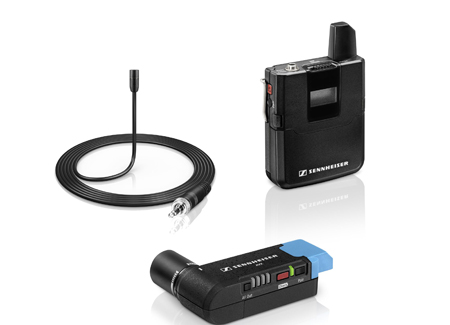Dubai-based sound recordist Simon Charles, from Carbide Sound, takes the Sennheiser AVX digital wireless system for a field test and shares his experience exclusively with BroadcastPro ME I recently had the opportunity to test out Sennheisers latest AVX digital wireless system, and I jumped at the chance, as it has been on my kit radar since […]
 Dubai-based sound recordist Simon Charles, from Carbide Sound, takes the Sennheiser AVX digital wireless system for a field test and shares his experience exclusively with BroadcastPro ME
Dubai-based sound recordist Simon Charles, from Carbide Sound, takes the Sennheiser AVX digital wireless system for a field test and shares his experience exclusively with BroadcastPro ME
I recently had the opportunity to test out Sennheisers latest AVX digital wireless system, and I jumped at the chance, as it has been on my kit radar since it was announced at NAB last April. I was, however, not looking at it for wireless microphone use but as a ‘camera hop’ for sending audio from my sound bag to a camera.
Lets look into what you get in the kit.
I received all the items available for the AVX system, which includes the Lavalier Pro Set as well as the handheld with both the cardioid and omni-directional mic heads. The Lavalier Pro set comprises the AVX plugin receiver, belt pack transmitter and the MKE-2 microphone, which is smaller and higher quality compared to the ME-2, which comes with the standard Lavalier set. A hot-shoe adaptor and XLR to 3.5mm jack cable for the receiver is included for use on a digital SLR / mirrorless camera system.
As a long-time user of Sennheiser equipment, I was expecting the solid build quality and well thought-out designs that Ive come to enjoy over the years. The AVX system lived up to all expectations. Both the transmitter and the receiver have a metal body, with solid-feeling plastic used for the antennas and batteries. The batteries are removable and connect solidly to the main units with a reassuring click.
One of the most striking things about the AVX system is the tiny size of the receiver (EKP-AVX), only a little larger than a right-angled XLR connector and not much heavier! This is a huge advantage if you are trying to reduce the clutter that seems to build up on cameras these days. Being able to plug directly into the XLR input means no cable is needed, and if you are using the hot-shoe option, even with the supplied XLR to 3.5mm cable, the unit is lighter and smaller than, for example, a Sennheiser G series receiver. Being able to rotate the receiver 320 degrees around its XLR connector is a major advantage, offering greater flexibility when connecting to cameras and other kit.
The bodypack transmitter (SK-AVX) also comes in a new design with a short, solid antenna, rather than the whip style that you find on other systems. This is due to the AVX using a digital transmission system rather than analogue. The metal belt clip on the rear of the unit is solid, has a stiff grip and should hold on to whatever its clipped to. The input uses the same locking 3.5mm socket found on Sennheiser G series or similar Sony wireless systems. This is great news for anyone changing to the AVX, as you dont have to discard any cables or microphones.
If you are familiar with setting up wireless systems, you will have come across small displays with apparently never-ending options. The AVX system is different: there is no menu, none at all. The receiver has no LCD display, just four LEDs and three buttons. The transmitter has two buttons on the side and a mute switch on the top, as well as a small LCD which displays basic information (RF level, battery time remaining and the name of the connection). I was disappointed that there is no backlight, as it is rather difficult to see in anything other than bright light.
Unlike almost all other wireless systems, there are no frequencies to set. To connect the devices together, you just have to pair them; this is a very easy process. Once paired, the units connect to each other automatically when turned on and remember the pairing until the process is repeated. This is very convenient and works flawlessly. Something to note is that, for now, only one receiver can be paired per transmitter for multi-camera set-ups require multiple systems. I hope this will change with a future firmware update.
Although its not something I generally use in my type of work, I did check out the handheld transmitter (SKM AVX-S). I was impressed with the build quality; it was solid in the hand, had a reassuring weight to it and felt very comfortable to hold. The version I had, the SKM AVX-S, included a mute switch under the LCD screen. This is certainly the one I recommend; the power switch is small and it takes a few seconds for paired devices to connect.
With this option, you can leave the devices on but mute the audio. The SKM handheld comes with the cardioid head as standard, which is great for the majority of uses. Also available is an omni-directional head. To change the heads, you just have to unscrew one and screw on the other. This is easily done and the connection is very solid.
I have been using Sennheiser microphones for years and recently purchased ultra-miniature MKE-1 Lavalier microphones for my WisyCom radios. The MKE-2 is slightly larger than the MKE-1, but not much, and is still easy to hide under clothes or using the supplied tie-clip. The quality of the audio it produces is excellent, with low self-noise and a rich, natural tone that I rather liked. Its certainly a major step up from the standard ME-2 microphone included with the Lavalier kit.
I decided to use the system while working on the Drones 4 Good competition in Dubai Internet City early this year. I felt that this would be a good challenge for the system, as there would be high-speed Wi-Fi and other digital signals in a very confined area. The AVX works on 1.9GHz, close to the 2.4GHz that most Wi-Fi and other communication devices use. I thought this might cause issues, but I was wrong there were no problems at all! This may have something to do with the AVX continually monitoring its operating frequency to make sure its using the cleanest channel available.
I had no dropouts, interference or connection issues at all, over the three days. I was using the system as a camera hop between my sound bag and the camera, in this case a Sony EX1. I had the receiver plugged into the cameras XLR socket and set the input control to MIC-48v. This turns the receiver on and off with the camera, a great way to save battery life.
Removable battery packs, lasting over 10 hours for the transmitter and around five hours for the receiver, power the system. The batteries have a micro-USB connector for charging and, very conveniently, powering the units. Having a spare battery is always recommended, but a constant power supply is definitely an advantage.
It worried me that there was no user control over the input level of the transmitter. It automatically determines if you have a line or mic input by the way the input jack is wired. This is similar to the G Series, but at least that gives you level control. The AVX uses a kind of advanced auto level control system, but I heard very little variance in levels. Once I had a level set on the camera though, I was very happy with it. It limits the level if you suddenly get a loud sound, but comes back to normal very quickly. The receiver does have an output attenuation control with levels at 0dB, -10dB, -20dB and -30dB, indicated by the LEDs. It outputs at mic level so that it can detect the 48v phantom power to turn on and off with the camera.
In general, I was extremely impressed with the AVX system. The design and build quality is excellent, and the use of advanced digital transmission and audio processing makes it very attractive. Its certainly aimed more towards the lone cameraman rather than professional sound recordists, but Im sure the AVX will be part of my kit in the near future.
Simon Charles is a location sound recordist based in Dubai. He works on a variety of projects including commercials, feature films, corporate productions and events.











































































